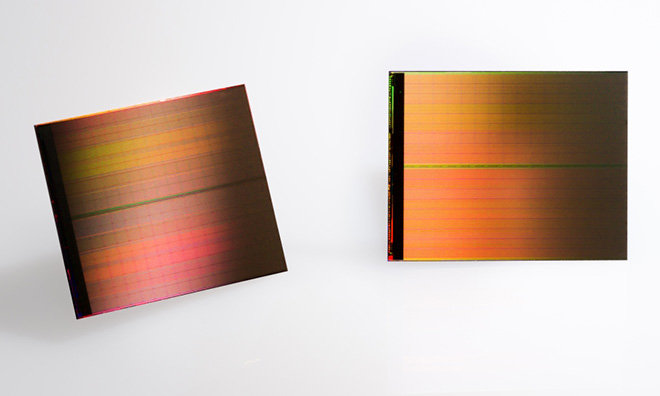Semiconductor technology giants Intel and Micron on Tuesday announced 3D XPoint memory, the fruits of a joint endeavor into non-volatile memory technology the companies claim is the first major breakthrough in the space since the introduction of NAND flash in 1989.
On paper, 3D XPoint sounds like a cure-all for modern computer memory bottlenecks. The technology is said to be up to 1,000 times faster than NAND with up to 1,000 times greater endurance, while packing in 10 times the density of conventional DRAM components.
The culmination of more than a decade of research and development, 3D XPoint boasts what is described as a stackable, transistor-less "three-dimensional checkerboard" architecture in which memory cells can be addressed individually as they sit at the intersection of word and bit lines. This design allows the system to write and read data in smaller batches, which in turn facilitates faster and more efficient operation. And with low latency overhead, a single 3D XPoint module can serve both system and storage needs.
Perhaps most impressive is that 3D XPoint is not a one-off proof of concept, but is already in early stages of production.
"One of the most significant hurdles in modern computing is the time it takes the processor to reach data on long-term storage," said Mark Adams, president of Micron. "This new class of non-volatile memory is a revolutionary technology that allows for quick access to enormous data sets and enables entirely new applications."
Any number of computing applications can benefit from such fast and efficient technology. For example, 3D XPoint could accelerate machine learning systems, or enable medical researchers to study genetics and track diseases in realtime, the companies said.
Intel and Micron plan to release sample units to select hardware manufacturers later this year and plan to roll out independent product lines through 2016.
 AppleInsider Staff
AppleInsider Staff








 Charles Martin
Charles Martin
 Christine McKee
Christine McKee
 Wesley Hilliard
Wesley Hilliard
 Malcolm Owen
Malcolm Owen
 Andrew Orr
Andrew Orr
 William Gallagher
William Gallagher
 Sponsored Content
Sponsored Content








55 Comments
[quote name="AppleInsider" url="/t/187396/intel-and-microns-new-3d-xpoint-memory-is-1000x-faster-more-durable-than-nand#post_2753936"]The technology is said to be up to 1,000 times faster than NAND with up to 1,000 times greater endurance, while packing in 10 times the density of conventional memory.[/QUOTE] Any chance this could place the system NAND on Apple's A-series package for an even smaller logic board? [QUOTE]Perhaps most surprising is that 3D XPoint is not a one-off proof of concept, but is already in production.[/QUOTE] That is both welcome and surprising. [QUOTE]Intel and Micron plan to release sample units to select hardware manufacturers later this year.[/quote] Great, but what kind of cost per gibibyte are we talking here? What kind of write count are we talking?
It's a cure-all for modern computer memory bottlenecks? I think IGZO and Liquid Metal have competition in the unicorn department! The next iPad is doomed without it!
Wow!
Never underestimate Intel.
Sounds very cool. Once the production costs go down this will spell the end of disk drives. My main question is how long until Samsung tries to steal the technology and try and sell it themselves.